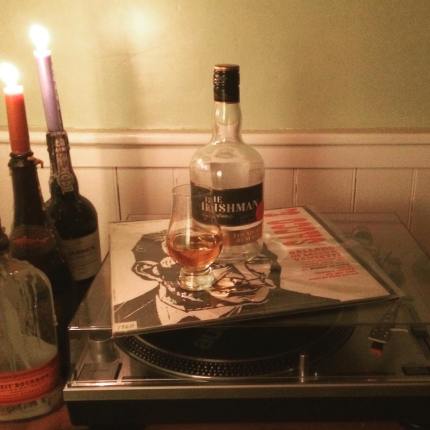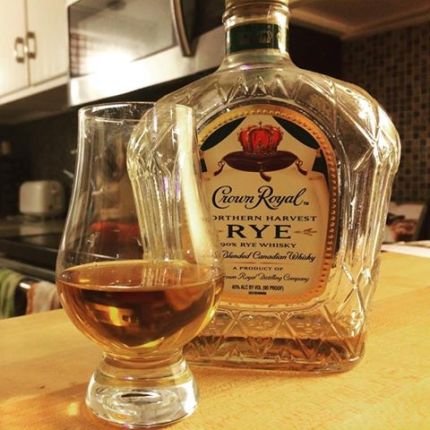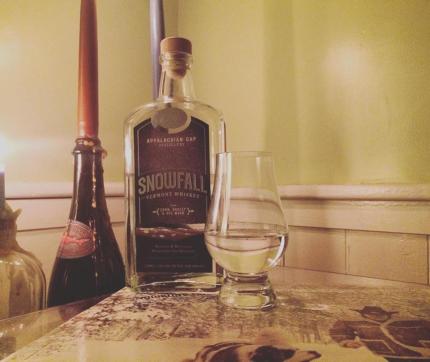As we reached the bend, just ahead of the final summit, we crossed paths with the Tallest Man on Earth. We’d passed through over a thousand feet of elevation, ice and snow, before the gateman gave warning. According to the Tallest Man, ahead were slicks of ice running right off the cliffs, perilous for even the best equipped. He had carbide spikes in his shoes, he showed. We did not, nor did the petite pup, Buster, who was our accompaniment. As we thanked the Tallest Man, who I feel at this point obliged to note was not even the tallest man present, but who bore a striking resemblance to a Mr. Kristian Matsson, (stage name the Tallest Man on Earth) we decided we would move forward and assess our assets and risks for ourselves. We walked about 20 feet forward, reviewed our supplies and the map. I found the perfect scapegoat in Buster, for of course our adventurous party could navigate the ice cliffs without fear, but what of the poor little dog? We turned back that day, turned back from the ridge, out of a learned and measured caution, knowing it was perhaps not what we had preferred to do, but what was right to do. The Camel’s Hump, that day, was just out of reach.
A day prior, our adventures were of a far different nature. The party of this confused and ambling story, Monseigneur Charlie his lovely fiancée Megan and I, went to the lovely town of Middlebury, Vermont at my strictest urgings. It presented the opportunity for long scenic drives, but more importantly, I was in pursuit of a certain spirit. Months ago, if you’ll kindly scroll the homepage, I found myself in possession of the finest white whiskey I can recall, Appalachian Gap’s Snowfall. It was remarkably unusual in character, possessed a certain flavor profile that defied all needs of characterization beyond “delicious.” Then I heard the aged version was out, Ridgeline. In short summary, Ridgeline is Snowfall self-actualized. Like your sophisticated friend who’s travelled the world and returned with a new perspective, Ridgeline has traveled the barrels, and grown deeper, darker, and unlike your traveling friend, richer. This whiskey does it’s time swapping between full-sized (53 gallon I believe?) fresh oak, ex-bourbon, and ex-port wine barrels taking some time to reach a ruby amber maturity. But more on that later.
On our fine day trip, after some wanderings and google map mishaps, we located the sought after distillery. We entered shortly before their planned closing hours due to our travels, and found ourselves the only visitors. Hoping the outfit would recall my prior kind words, I introduced myself, and attempted to use any credibility this collection of mumbled minuets could buy me to curry favor. Fortunately, the gents recalled my praise for their labors, and we struck up easy report. They permitted us samples of each of their products, including some secret projects I cannot divulge on, because I’ve already broken my word to keep quiet on them. I’m sorry guys; I want to seem cool, like I get special privileges for writing and junk. Anyways, the visit to Appalachian Gap was well worth our trip, and the gentlemen distillers treated us with the utmost kindness, and exalted true joy in their craft, in spite of one of them mildly splitting his head open on a shelf in mid conversation.
In the course of our conversations, they shared their story and their passion. For them, Ridgeline was a journey of trial and error and discovery. They’d spent time perfecting their mash in making Snowfall, an effort which clearly reached its summit, and now they were hoping to reach their pinnacle in Ridgeline. They planned to take no short-cuts, no small barrels, brief aging, to take the metaphor as far as I can stretch it, they were willing to bushwhack their way to the peak if required. We spoke to them of our plans to hike Camel’s Hump, and they gave us words of warning which we should have heeded, noting that word about was that it was a skating rink. We were too brash for warnings. They also told us that the distillery itself was named for childhood hikes in the Green Mountains in a region known as the Appalachian Gap. Given the distances I’d traveled to taste the distillate of their labors, I found it necessary as our visit ended to take a bottle home, and for my prior pseudo-poetics they rewarded me with one of their hats for the parting, which I have taken with me on all of my hikes since. On parting, I told them I would share my impressions, once fully written, and I have regrettably procrastinated on them for several months, saving the last half of the bottle for the writing as a restricted corner of the bar for some future inspired Ryan to drink. Now’s as good a time as any…but before that, back to the ridge.
While good sense kept us from seeking the peak of the Camel’s Hump, our team would not turn back in utter defeat. Instead, on review of the map, we plotted a new course. Our renegotiated path would be to follow the Long Trail, looping back south to steal the peak of Mt. Ethan Allen, the Green Mountain boy himself. We found ourselves following only one set of footsteps in the fresh snow on the Long Trail, which deepened with each foot of elevation, and as we neared a shelter on the trail we once again met up with the Tallest Man. After moments of balking at the anti-bear defenses of the shelter, we proceeded,with the Tallest Man on recon, to break trail through the virgin snow towards Ethan. The Tallest Man, who it turns out is a Torontonian engineer and well regarded mountain biker named Chris, spoke to us about his well-founded confusion with the current state of American politics, particularly the phenomenon of Donald Trump, and we shared his views. Meanwhile the snow continued to get deeper, and the diminutive Buster began to struggle; the trail became less clear.
We tramped onwards, Buster leaping between footprints, Tallest Man and I digging our way forward, until finally it leveled, and there was a brief break in the trees, overlooking the Appalachian Gap. Or so I will claim, for the purposes of poetics and all that bullshit. We rested, satisfied at having found our peak, and I proffered my flask of Old Grandad (bonded) to Mr. Charlie and Tallest Man, passing it about as I set my Jetboil in the snow and fired it up for a restorative coffee, which I bollock’ds up into a boiling mess of coffee grounds. Nevertheless, the boiling mess restored feeling to my hands, we took one last look over the Gap, and we departed together with a successful expedition at our backs.
Much like a hike along a New England ridgeline, the process of making whiskey is one of exertion, unpredictability and adaptation. While the hiker may be forced to seek an alternate route, the distiller may be forced to dump a whole batch and reformulate their mash. Worse, the whiskey may spend years in the barrel, only to turn out to be a wash of malign flavors. As a hiker (and also as a drinker I suppose) I am often toiling to reach a height of sublime beauty from which I can see the world lay bare below me. As a distillery, Appalachian Gap is hoping to make Ridgeline that peak. So what shall I say of the Ridgeline?

I should begin by stating what Ridgeline is: malt whiskey and bourbon had a baby. With a bill of 45% malted barley, 30% corn and 15% rye, as well as the aforementioned barrel combination, I cannot think of a whiskey on a similar track. On the nose this distinct recipe yields an intriguing interplay of crisp pear and darker plum notes with an underlying base of rich molasses, somehow without a single hint of alcohol in spite of the robust 98 proof behind it. Similarly, the taste of the whiskey strikes a tantalizing balance between a fine highland scotch and a downhome Kentucky bourbon. The first taste gives me a very crisp green apple note that somehow gains spice and warmth more tantamount to an apple pie with every second I let it linger. Each successive sip leads to me finding new flavors, pear, vanilla, sweet corn and sherry. I feel as though each sip I take could lead me to change my flavor profile, but I promise to stop overthinking it, and just tell you it’s somehow a balance of warmth, light esters and crisp fruit. I suspect that doesn’t make any sense, so I’m going to have to tell you, just get a bottle for yourself. The finish, similarly is warm, with a lovely sweet spice that I can only compare to a fine monkey bread.
After a brief two days journey, which admittedly took several months to write about, I departed from my dear friends Megan and Charlie, returning home with a bottle of whiskey, probably a hangover, and a lesson of the trail. Obstacles are opportunities, and forging a new path, in whiskey or fresh snow, can bring great rewards.







